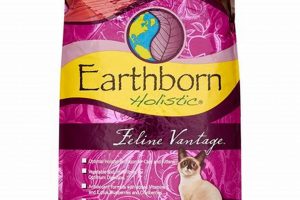Selecting the optimal nutritional plan for a young Australian Shepherd is crucial for its healthy development. This choice involves considering factors such as breed-specific needs, activity levels, and potential sensitivities to ingredients. The goal is to provide a balanced diet that supports growth, energy, and overall well-being during the critical puppy stage.
Proper nutrition in early life has far-reaching benefits, influencing bone and muscle development, immune system strength, and cognitive function. A well-formulated diet contributes to a shiny coat, healthy digestion, and a decreased risk of developing certain health issues later in life. Historically, the understanding of canine nutritional needs has evolved, leading to advancements in puppy food formulations tailored to specific breeds like the Australian Shepherd.
Therefore, a thorough examination of commercially available puppy food options is essential. This includes evaluating ingredient lists, nutritional profiles, and manufacturer reputations to determine the most suitable feeding plan. Key considerations will involve protein sources, carbohydrate types, fat content, and the inclusion of essential vitamins and minerals.
Guidance for Nutritional Planning
Selecting the appropriate nutrition for a young Australian Shepherd necessitates careful consideration. The following guidance provides a framework for informed decision-making.
Tip 1: Prioritize Breed-Specific Formulas: Select puppy food specifically formulated for medium to large breeds. These formulations address the rapid growth rates and unique nutritional requirements of breeds such as the Australian Shepherd, helping to prevent developmental orthopedic diseases.
Tip 2: Analyze Protein Sources: Identify the primary protein source within the ingredient list. High-quality animal proteins, such as chicken, lamb, or fish, should be prominently featured. Avoid foods where plant-based proteins are the dominant ingredient.
Tip 3: Evaluate Fat Content: Assess the fat content to ensure it aligns with the Australian Shepherd puppy’s energy needs. A moderate fat level is essential for supporting growth and cognitive development. Consult feeding guidelines provided by the manufacturer to determine the appropriate quantity.
Tip 4: Scrutinize Carbohydrate Sources: Opt for easily digestible carbohydrate sources, such as brown rice or oatmeal. Minimize the inclusion of fillers or grains that offer limited nutritional value. Be wary of excessive corn, wheat, or soy.
Tip 5: Consider Added Supplements: Examine whether the puppy food contains essential vitamins, minerals, and omega fatty acids. These supplements contribute to healthy skin, coat, and overall well-being. If the food is deficient, supplementation may be required following veterinary consultation.
Tip 6: Monitor Caloric Intake: Adhere to the manufacturer’s feeding guidelines, adjusting portions as needed based on the puppy’s activity level and body condition. Regular weight monitoring is critical to prevent overfeeding or underfeeding.
Tip 7: Consult with a Veterinarian: Seek professional guidance from a veterinarian experienced with Australian Shepherds. A tailored nutritional plan, based on the individual puppy’s health status and needs, can be formulated.
Adherence to these guidelines facilitates the provision of optimal nutrition, supporting the healthy growth and development of Australian Shepherd puppies. Diligent monitoring and adjustments are necessary to ensure ongoing well-being.
These tips offer a foundation for making informed choices, but a comprehensive nutritional strategy benefits from further exploration of specific food brands and ingredient analysis.
1. Nutrient Profiles
The nutrient profile of food intended for Australian Shepherd puppies exerts a direct influence on their development and long-term health. An inadequate or imbalanced profile can result in stunted growth, skeletal abnormalities, and compromised immune function. Conversely, a meticulously formulated profile addresses the specific needs of this breed during its rapid growth phase, fostering optimal muscle development, bone density, and cognitive function. For example, a diet deficient in calcium and phosphorus can predispose a growing Australian Shepherd to hip dysplasia, a common concern within the breed. Therefore, the nutrient profile is a critical determinant of a food’s suitability.
Specifically, the protein content within the nutrient profile is vital for supporting the Australian Shepherd’s high energy demands and muscle development. A protein source lacking in essential amino acids hinders tissue repair and overall growth. Similarly, the balance of omega-3 and omega-6 fatty acids affects coat health and cognitive development. The presence of antioxidants within the profile is significant for bolstering the immune system, offering protection against oxidative stress. Practical application involves carefully examining the guaranteed analysis and ingredient list to ensure a sufficient supply of these key nutrients. Choosing products certified by recognized veterinary nutritional organizations provides further assurance of nutrient adequacy.
In conclusion, the nutrient profile is not merely a descriptive element of puppy food; it is a fundamental component influencing the Australian Shepherd’s health trajectory. Challenges lie in interpreting complex labels and understanding individual puppy needs. Despite these difficulties, a commitment to understanding nutrient profiles, coupled with veterinary consultation, serves as a crucial safeguard in promoting the healthy development of this intelligent and active breed.
2. Breed Predisposition
Breed predisposition represents a critical consideration in the selection of optimal puppy food for Australian Shepherds. This breed’s genetic heritage predisposes it to certain health vulnerabilities, necessitating a proactive dietary approach to mitigate potential risks and support overall well-being.
- Sensitivity to Certain Ingredients
Australian Shepherds, like many herding breeds, exhibit heightened sensitivity to certain ingredients. Common culprits include grains like corn, wheat, and soy, which can trigger allergic reactions manifested as skin irritations, digestive upset, or chronic ear infections. Selecting a puppy food formulated without these common allergens can minimize the risk of adverse reactions and promote digestive health.
- Increased Risk of Hip and Elbow Dysplasia
Larger breeds, including Australian Shepherds, are predisposed to hip and elbow dysplasia, developmental orthopedic conditions. Rapid growth rates exacerbate this risk. Puppy food formulations specifically designed for large breeds often contain controlled levels of calcium and phosphorus, along with glucosamine and chondroitin, to support healthy joint development and minimize the likelihood of these conditions.
- Potential for Drug Sensitivities
Australian Shepherds possess a higher incidence of the MDR1 gene mutation, leading to increased sensitivity to certain drugs. While diet cannot directly address this genetic condition, it underscores the importance of meticulous ingredient selection. Minimizing exposure to artificial additives, preservatives, and dyes found in some puppy foods can reduce the overall toxic load on the system and support liver function, especially relevant given the potential for adverse drug reactions.
- Nutritional Needs for Coat Health
The Australian Shepherd’s distinctive double coat requires specific nutritional support to maintain its health and luster. A puppy food rich in omega-3 and omega-6 fatty acids, derived from sources like fish oil and flaxseed, promotes a healthy skin barrier, reduces inflammation, and contributes to a glossy, manageable coat. Deficiencies in these essential fatty acids can result in dry skin, a dull coat, and increased susceptibility to skin infections.
The interplay between breed predisposition and dietary selection is undeniable. Choosing a puppy food that acknowledges and addresses the specific vulnerabilities inherent in the Australian Shepherd breed is essential for promoting optimal health and preventing potential health issues. Diligent research and veterinary consultation are crucial steps in formulating a nutritional plan that caters to the unique needs of this breed.
3. Ingredient Quality
Ingredient quality represents a cornerstone in determining the suitability of puppy food for Australian Shepherds. The nutritional value and digestibility of food are directly correlated with the quality of its constituent components, impacting growth, development, and overall health.
- Source and Type of Protein
Protein, essential for muscle development and overall growth, should originate from identifiable animal sources such as chicken, lamb, or fish. The ingredient list should clearly indicate the specific protein source, avoiding ambiguous terms like “meat by-products” unless further specified and from a reputable origin. Higher-quality protein sources offer improved digestibility and a more complete amino acid profile, crucial for optimal growth in Australian Shepherd puppies. For instance, a puppy food listing “chicken meal” as the primary ingredient generally signifies a higher protein quality compared to one listing “corn gluten meal”.
- Fat Content and Source
Fats provide energy and support cognitive function. The source of fat is paramount. Ingredients such as fish oil, flaxseed oil, and chicken fat offer beneficial omega-3 and omega-6 fatty acids, promoting healthy skin and coat. Avoid foods relying on generic vegetable oils or fats derived from unidentified sources. The presence and proportion of these essential fatty acids directly impact the coat’s sheen and the skin’s integrity, critical for the Australian Shepherd’s characteristic double coat.
- Carbohydrate Digestibility and Fiber Content
Carbohydrates supply energy, but their digestibility varies significantly. Easily digestible carbohydrates, such as brown rice or oatmeal, are preferable to less digestible options like corn or wheat. Fiber content, derived from sources like beet pulp or pea fiber, supports digestive health and regular bowel movements. Insufficient fiber can lead to digestive upset, while indigestible carbohydrates offer minimal nutritional value. A balance between digestible carbohydrates and appropriate fiber is essential for maintaining gastrointestinal health in Australian Shepherd puppies.
- Presence of Artificial Additives and Fillers
The absence of artificial colors, flavors, and preservatives is indicative of higher ingredient quality. These additives provide no nutritional value and may trigger sensitivities or allergic reactions in some puppies. Fillers, such as corn gluten meal or soybean hulls, contribute bulk but offer minimal nutritional benefit. Prioritizing foods with a shorter ingredient list, composed primarily of whole, identifiable ingredients, reduces the risk of exposure to potentially harmful additives and fillers.
In summary, ingredient quality dictates the nutritional value and overall health benefits derived from puppy food. Selecting a product with clearly identified, high-quality protein and fat sources, easily digestible carbohydrates, and minimal artificial additives contributes significantly to the healthy development of Australian Shepherd puppies. This rigorous evaluation process enhances the likelihood of providing a diet that supports optimal growth and minimizes potential health complications.
4. Digestive Health
Digestive health represents a critical factor in determining the suitability of any puppy food, especially for Australian Shepherds. The breed’s predisposition to sensitivities and potential digestive issues underscores the necessity of selecting a formulation that promotes optimal gastrointestinal function. Improper digestion can lead to nutrient malabsorption, resulting in stunted growth, weakened immunity, and chronic health problems. The connection is direct: a puppy food that supports digestive health contributes significantly to the overall well-being and development of the Australian Shepherd.
Consider, for instance, the consequences of feeding a puppy food containing high levels of difficult-to-digest ingredients, such as corn or wheat. The undigested material can ferment in the gut, leading to gas, bloating, diarrhea, or even more severe conditions such as inflammatory bowel disease. Conversely, a food rich in prebiotics and probiotics promotes a healthy gut microbiome, enhancing digestion and nutrient absorption. The inclusion of digestible fiber sources, such as beet pulp or pumpkin, aids in regulating bowel movements and preventing constipation. Thus, digestive health should be a primary criterion when evaluating puppy food options.
In conclusion, the selection of puppy food for an Australian Shepherd necessitates a careful consideration of its impact on digestive health. Prioritizing formulations with high-quality, digestible ingredients, appropriate fiber content, and beneficial prebiotics/probiotics is crucial for supporting optimal gastrointestinal function. Failure to address digestive health can result in a cascade of adverse health consequences. Therefore, responsible ownership demands a proactive approach to ensuring the puppy’s digestive system thrives, enabling it to fully benefit from its diet and reach its full potential.
5. Growth Rates
Growth rates represent a pivotal consideration when determining the optimal nutritional plan for Australian Shepherd puppies. Rapid growth, while a natural phase of development, places significant demands on the puppy’s skeletal system and overall metabolic processes. The selection of puppy food directly influences the rate at which the puppy grows, with potential ramifications for long-term health. Excessive growth rates, often fueled by diets high in calories and certain minerals, can predispose Australian Shepherds to developmental orthopedic diseases such as hip and elbow dysplasia. Conversely, insufficient nutrient intake can hinder growth and compromise immune function, leaving the puppy vulnerable to illness. The relationship between growth rates and puppy food selection is, therefore, causal and critical. For example, a study examining large-breed puppies demonstrated that those fed a restricted-calorie diet with controlled calcium and phosphorus levels exhibited a significantly lower incidence of hip dysplasia compared to those fed ad libitum diets.
The “best puppy food” for Australian Shepherds is not merely about promoting rapid growth but about supporting optimal growth. This entails providing a balanced nutrient profile that aligns with the breed’s specific needs. Formulations designed for large-breed puppies typically contain lower levels of calcium and phosphorus than those intended for smaller breeds. This controlled mineral content helps to regulate bone growth, preventing the rapid deposition of minerals that can lead to skeletal abnormalities. Practical application involves carefully examining the guaranteed analysis on puppy food labels, paying particular attention to the calcium and phosphorus levels. Veterinarians often recommend specific calcium-to-phosphorus ratios for large-breed puppies to ensure proper bone development. Furthermore, monitoring the puppy’s body condition score is essential. A puppy that is excessively heavy or underweight may require adjustments to its feeding plan.
In summary, growth rates are inextricably linked to the selection of suitable puppy food for Australian Shepherds. The goal is to promote steady, controlled growth that supports skeletal health and minimizes the risk of developmental orthopedic diseases. This requires a meticulous approach to puppy food selection, emphasizing balanced nutrient profiles, controlled mineral content, and regular monitoring of the puppy’s body condition. Challenges include interpreting complex nutritional information and adapting feeding plans to individual puppy needs. However, the benefits of prioritizing controlled growth rates are substantial, contributing to a healthier, more active life for the Australian Shepherd.
6. Veterinary Guidance
Veterinary guidance constitutes an indispensable element in the selection of the most appropriate nutrition for Australian Shepherd puppies. The inherent variability among individual puppies, encompassing factors such as metabolic rate, activity level, and pre-existing health conditions, necessitates a personalized dietary approach. Generic recommendations, while potentially beneficial as starting points, often fail to address specific needs. A veterinarian, through physical examination, health history review, and diagnostic testing when warranted, can identify individual requirements and tailor dietary recommendations accordingly. The connection is direct: Veterinary assessment informs the selection of suitable nutrition, thereby optimizing health outcomes.
The practical significance of veterinary involvement extends beyond initial food selection. During the rapid growth phase, puppies undergo significant physiological changes. A veterinarian can monitor growth rates, body condition, and stool quality to assess the effectiveness of the chosen food and make necessary adjustments. For instance, if a puppy exhibits persistent digestive upset or fails to gain weight adequately, veterinary examination can rule out underlying medical conditions and guide dietary modifications, such as transitioning to a hypoallergenic formula or adjusting portion sizes. Veterinary expertise also proves invaluable in managing breed-specific predispositions. Australian Shepherds exhibit a heightened risk of certain health conditions, and dietary interventions, guided by veterinary recommendations, can play a crucial role in mitigating these risks. A real-world example involves managing the risk of hip dysplasia through controlled growth rates achieved with a veterinarian-recommended large-breed puppy food.
In summary, veterinary guidance represents an integral component of a comprehensive nutritional strategy for Australian Shepherd puppies. It moves beyond generalized recommendations to address individual needs, monitor growth and development, and manage breed-specific predispositions. The challenge lies in recognizing the importance of veterinary expertise and proactively seeking professional consultation. However, the benefits of this proactive approach are substantial, contributing to improved health outcomes and a higher quality of life for the Australian Shepherd.
Frequently Asked Questions
This section addresses common inquiries regarding the optimal dietary practices for Australian Shepherd puppies, providing clarity on crucial nutritional aspects.
Question 1: What constitutes the primary nutritional requirement for Australian Shepherd puppies?
The primary nutritional requirement centers on providing a balanced diet that supports their rapid growth and development. This necessitates a high-quality protein source, moderate fat content, and appropriate levels of essential vitamins and minerals.
Question 2: How does the selection of puppy food affect the likelihood of hip dysplasia in Australian Shepherds?
The selection of puppy food directly impacts the risk of hip dysplasia. Overfeeding and excessive calcium intake can accelerate growth rates, increasing stress on developing joints. Controlled growth through appropriate caloric intake and mineral balance is critical.
Question 3: What ingredients should be avoided in puppy food for Australian Shepherds due to potential sensitivities?
Ingredients to avoid include common allergens such as corn, wheat, soy, and artificial additives. These can trigger digestive upset, skin irritations, and other adverse reactions in sensitive individuals.
Question 4: How often should an Australian Shepherd puppy be fed?
Feeding frequency depends on the puppy’s age. Younger puppies require more frequent meals to support their rapid growth, typically three to four times per day. As they mature, the feeding frequency can be reduced to twice daily.
Question 5: What role does fiber play in an Australian Shepherd puppy’s diet?
Fiber plays a crucial role in maintaining digestive health. It aids in regulating bowel movements, preventing constipation, and promoting a healthy gut microbiome.
Question 6: Is grain-free puppy food necessary for all Australian Shepherds?
Grain-free puppy food is not inherently necessary unless the puppy exhibits a diagnosed grain allergy or sensitivity. However, if grains are included, they should be easily digestible options such as brown rice or oatmeal.
Optimal nutrition during puppyhood significantly impacts the long-term health and well-being of Australian Shepherds. Individual needs vary, necessitating attentive observation and potential adjustments to the feeding plan.
The subsequent section will delve into practical feeding schedules and portion control strategies to further enhance nutritional management.
Conclusion
The preceding exploration of the complexities surrounding the selection of optimal nutrition for Australian Shepherd puppies underscores the significance of informed decision-making. Key considerations encompass breed-specific needs, ingredient quality, digestive health, growth rate management, and the critical role of veterinary guidance. The identification of suitable nourishment fundamentally impacts the puppy’s development, long-term health, and overall well-being.
The ongoing commitment to providing Australian Shepherd puppies with appropriate nutritional support is an investment in their future. Continuous monitoring of growth, adaptation to evolving needs, and proactive veterinary consultation ensures their healthy development. Prioritizing informed decisions enhances the likelihood of a vibrant and active life for these intelligent canines.







